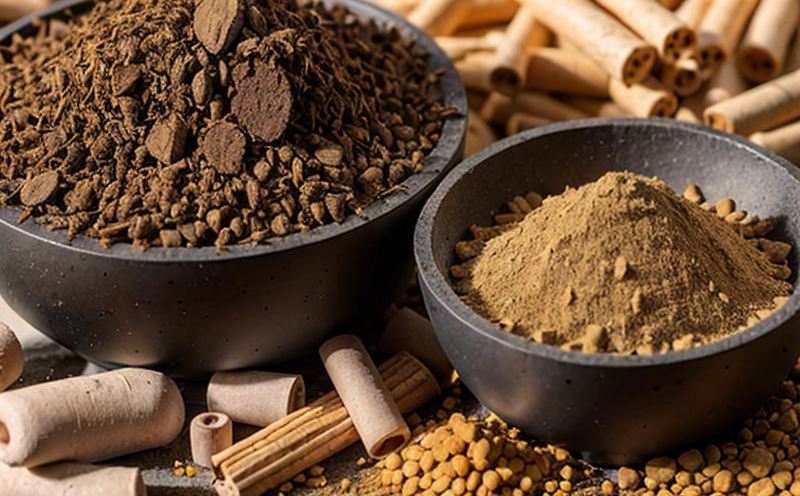EN 14774 Determination of Moisture Content in Biomass Fuels
The determination of moisture content is a critical aspect of biomass fuel testing. The European Standard EN 14774-2 sets forth the methodology for determining the volatile matter and fixed carbon in biomass fuels, which includes procedures to measure moisture content. This standard ensures that biomass fuels meet quality specifications essential for efficient combustion processes. Proper moisture content measurement helps in optimizing combustion efficiency, reducing emissions, and enhancing overall performance of bioenergy systems.
Biomass fuels derived from various sources such as wood, agricultural residues, and energy crops are subject to changes in their physical properties due to moisture variations. Moisture content directly influences calorific value (CV) and thermal conductivity, impacting the fuel's suitability for different applications like power generation or heating systems. Accurate measurement of moisture content is crucial for compliance with relevant regulations and standards, ensuring that fuels meet specific quality thresholds.
The EN 14774-2 standard specifies procedures applicable to all types of biomass fuels, including wood chips, pellets, briquettes, and other forms used in energy production. The testing method involves several steps: sample preparation, drying the sample under controlled conditions, weighing before and after drying, calculation of moisture loss, and determining final moisture content percentage.
Sample preparation typically includes sieving to ensure uniformity, which prevents discrepancies due to particle size differences. Controlled drying is achieved using forced-air ovens or vacuum desiccators at specific temperatures (typically 105°C ±2°C) until constant weight is reached. This process ensures that all bound and unbound moisture has been removed without altering the chemical composition of the fuel.
Once dried, samples are weighed accurately to determine initial mass. After drying, they are reweighed to calculate the loss in mass due to evaporation of water. The difference between these two measurements provides the moisture content percentage according to the formula:
- Moisture Content (%) = (Mass Before Drying - Mass After Drying) / Mass Before Drying × 100
This calculation is straightforward yet essential for ensuring accurate results. Compliance with EN 14774-2 guarantees that moisture content determinations are consistent across laboratories, supporting reliable quality assessments.
The importance of this standard extends beyond mere compliance; it plays a pivotal role in optimizing bioenergy systems by providing precise data on fuel properties. By accurately measuring moisture content, operators can adjust combustion parameters accordingly to achieve optimal performance and efficiency.
Applied Standards
EN 14774-2 is widely recognized for its comprehensive approach to determining the moisture content in biomass fuels. It aligns with other internationally accepted standards such as ISO 178, which covers determination of volatile matter and fixed carbon content; ASTM D5309, focusing on lignin content; and EN 14961, dealing with ash content.
These standards complement each other by addressing different parameters critical for assessing biomass fuel quality. Together they form a robust framework supporting consistent testing methodologies across various sectors including power generation, heating systems, and industrial applications.
| Biomass Fuel Type | Standard | Main Focus |
|---|---|---|
| Wood Chips | EN 14774-2 | Determination of moisture content |
| Briquettes | ISO 178 | Determination of volatile matter and fixed carbon content |
| Pellets | ASTM D5309 | Lignin content determination |
| Energy Crops | EN 14961 | Ash content assessment |
The integration of these standards into industry practices ensures that biomass fuels are evaluated comprehensively, leading to improved combustion efficiency and reduced emissions.
Competitive Advantage and Market Impact
- Innovation in Biomass Testing: Compliance with EN 14774-2 allows companies to stay ahead of regulatory changes and market demands. Accurate moisture content measurements enhance product quality, ensuring better performance across diverse applications.
- Regulatory Compliance: Adhering to this standard ensures that businesses meet stringent environmental regulations worldwide, providing a competitive edge by demonstrating commitment to sustainability practices.
- Customer Satisfaction: Reliable testing results build trust with customers and stakeholders, fostering long-term relationships based on quality assurance.
- Economic Efficiency: By optimizing fuel usage through precise moisture content determination, companies can reduce operational costs while maintaining high standards of service delivery.
In the rapidly evolving renewable energy sector, meeting these stringent testing criteria not only sets a benchmark for excellence but also positions organizations as leaders in sustainability and innovation. Compliance with EN 14774-2 is crucial for maintaining market share and attracting investment from environmentally conscious stakeholders.
Use Cases and Application Examples
The application of EN 14774-2 is extensive, covering numerous sectors within the renewable energy industry. Here are some specific use cases:
| Application | Description |
|---|---|
| Biomass Power Plants | Determining moisture content helps in optimizing combustion processes, ensuring efficient conversion of biomass into electricity. |
| Heating Systems | Avoidance of excessive moisture can prevent equipment damage and improve operational reliability. |
| Biofuel Production Facilities | Maintenance of optimal moisture levels ensures consistent fuel quality, enhancing its suitability for various end-use applications. |
| Research and Development | Accurate data on moisture content facilitates the development of more efficient biomass utilization technologies. |
| Supply Chain Management | Ensuring consistent moisture levels in delivered fuels supports supply chain integrity, reducing variability in performance across different batches. |
| Agricultural Waste Utilization | Mitigation of moisture content issues improves the effectiveness of converting agricultural residues into valuable biofuels. |
| Energy Crop Farms | Monitoring moisture content during harvesting and storage optimizes yield and reduces post-harvest losses. |
The widespread adoption of EN 14774-2 across these diverse applications underscores its significance in promoting sustainable energy solutions.





